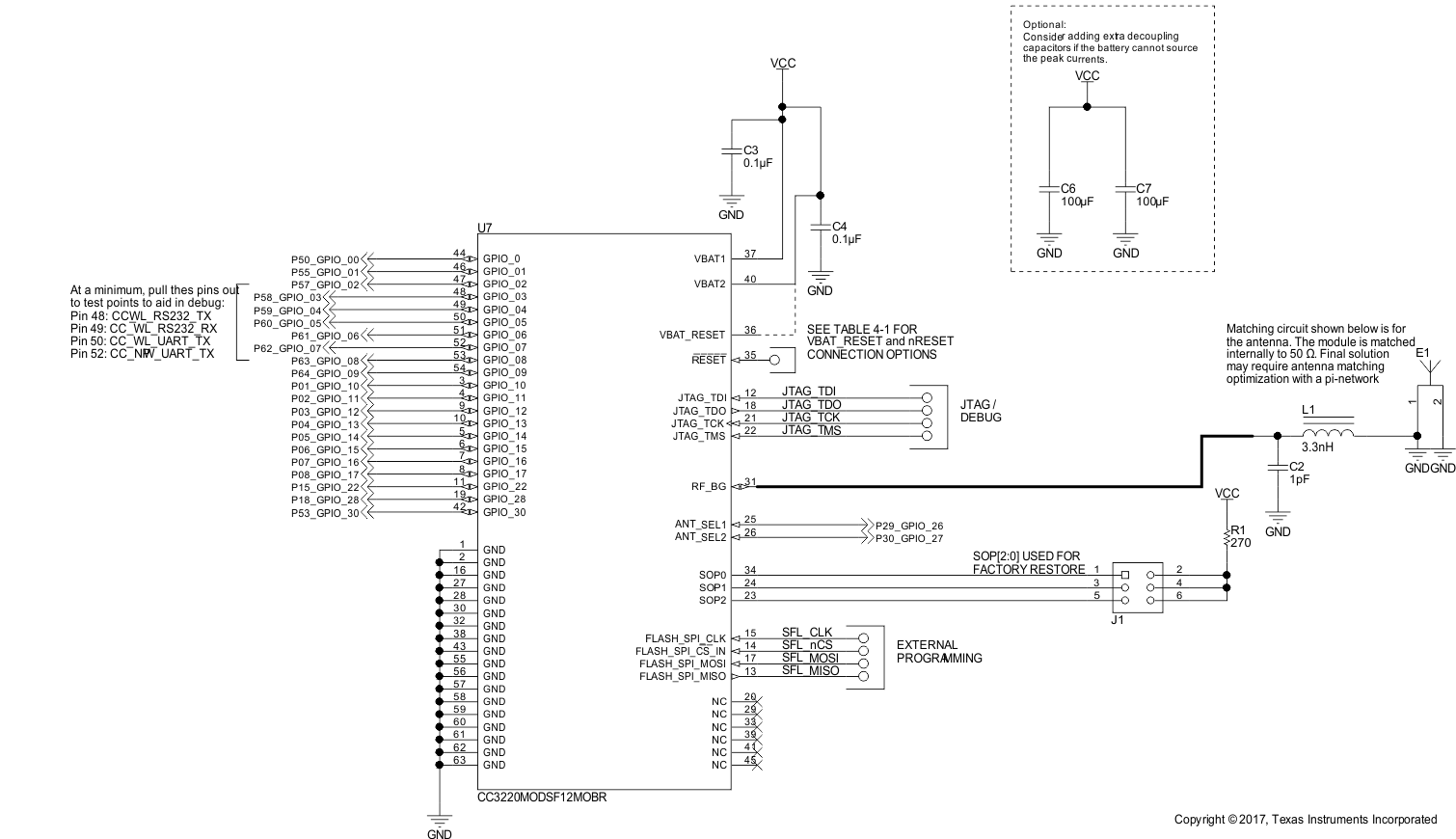SWRS206E March 2017 – May 2021 CC3220MOD , CC3220MODA
PRODUCTION DATA
- 1 Features
- 2 Applications
- 3 Description
- 4 Functional Block Diagrams
- 5 Revision History
- 6 Device Comparison
- 7 Terminal Configuration and Functions
-
8 Specifications
- 8.1 Absolute Maximum Ratings
- 8.2 ESD Ratings
- 8.3 Recommended Operating Conditions
- 8.4 Current Consumption (CC3220MODS and CC3220MODAS)
- 8.5 Current Consumption (CC3220MODSF and CC3220MODASF)
- 8.6 TX Power and IBAT Versus TX Power Level Settings
- 8.7 Brownout and Blackout Conditions
- 8.8 Electrical Characteristics
- 8.9 CC3220MODAx Antenna Characteristics
- 8.10 WLAN Receiver Characteristics
- 8.11 WLAN Transmitter Characteristics
- 8.12 Reset Requirement
- 8.13 Thermal Resistance Characteristics for MOB and MON Packages
- 8.14
Timing and Switching Characteristics
- 8.14.1 Power-Up Sequencing
- 8.14.2 Power-Down Sequencing
- 8.14.3 Device Reset
- 8.14.4 Wake Up From Hibernate Timing
- 8.14.5 Peripherals Timing
-
9 Detailed Description
- 9.1 Overview
- 9.2 Arm® Cortex®-M4 Processor Core Subsystem
- 9.3 Wi-Fi® Network Processor Subsystem
- 9.4 Security
- 9.5 Power-Management Subsystem
- 9.6 Low-Power Operating Mode
- 9.7 Memory
- 9.8 Restoring Factory Default Configuration
- 9.9 Boot Modes
- 9.10 Device Certification and Qualification
- 9.11 Module Markings
- 9.12 End Product Labeling
- 9.13 Manual Information to the End User
- 10Applications, Implementation, and Layout
- 11Environmental Requirements and Specifications
- 12Device and Documentation Support
- 13Mechanical, Packaging, and Orderable Information
Refer to the PDF data sheet for device specific package drawings
Mechanical Data (Package|Pins)
- MON|63
Thermal pad, mechanical data (Package|Pins)
10.1 Typical Application
Figure 10-1 shows the typical application schematic using the CC3220MODx module.
Note that the CC3220MODx and CC3220MODAx modules share the same reference schematic. The difference between the two references is the antenna and its matching circuitry. Pin 31 is not accessible to the designer in the CC3220MODAx module, because it contains an integral antenna. See the full reference schematics for CC3220MODx and CC3220MODAx.

Table 10-1 provides the bill of materials for a typical application using the CC3220MODx module in Figure 10-1.
Note that the CC3220MODx and CC3220MODAx modules share the same reference BOM. The difference between the two references is the antenna and its matching circuitry. Pin 31 is not accessible to the designer in the CC3220MODAx module, because it contains an integral antenna. See the full reference schematics for CC3220MODx and CC3220MODAx.
| QTY | PART REFERENCE |
VALUE | MANUFACTURER | PART NUMBER | DESCRIPTION |
|---|---|---|---|---|---|
| 1 | C2(1) | 1 pF | Murata | GRM1555C1H1R0BA01D | Capacitor, ceramic, 1 pF, 50 V, ±10%, C0G/NP0, 0402 |
| 3 | C3, C4, C5 | 0.1 µF | Murata | GRM155R61A104KA01D | Capacitor, ceramic, 0.1 μF, 10 V, ±10%, X5R, 0402 |
| 2 | C6, C7 | 100 µF | Murata | LMK325ABJ107MMHT | Capacitor, ceramic, 100 μF, 10 V, ±20%, X5R, AEC-Q200 Grade 3, 1210 |
| 1 | E1(1) | 2.45-GHz Ant | Taiyo Yuden | AH316M245001-T | Antenna Bluetooth WLAN ZigBee® WIMAX |
| 1 | L1(1) | 3.3 nH | Murata | LQG15HS3N3S02D | Inductor, multilayer, air core, 3.3 nH, 0.3 A, 0.17 Ω, SMD |
| 1 | R1 | 270 | Vishay-Dale | CRCW0402270RJNED | RES, 270, 5%, 0.063 W, 0402 |
| 1 | U1 | CC3220MODSF | Texas Instruments | CC3220MODSF12MOBR | SimpleLink™ Wi-Fi® and Internet-of-Things Module Solution, a Single-Chip Wireless MCU, MOB0063A (SIP MODULE-63) |